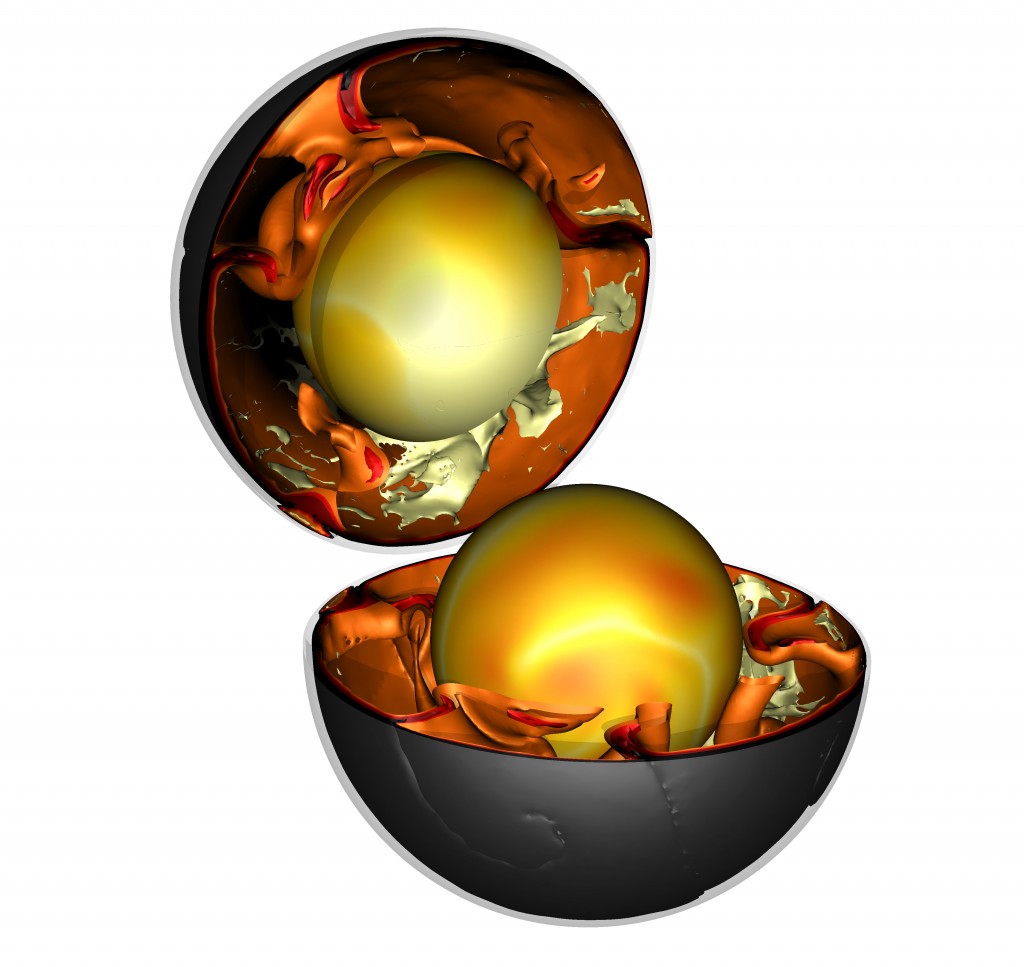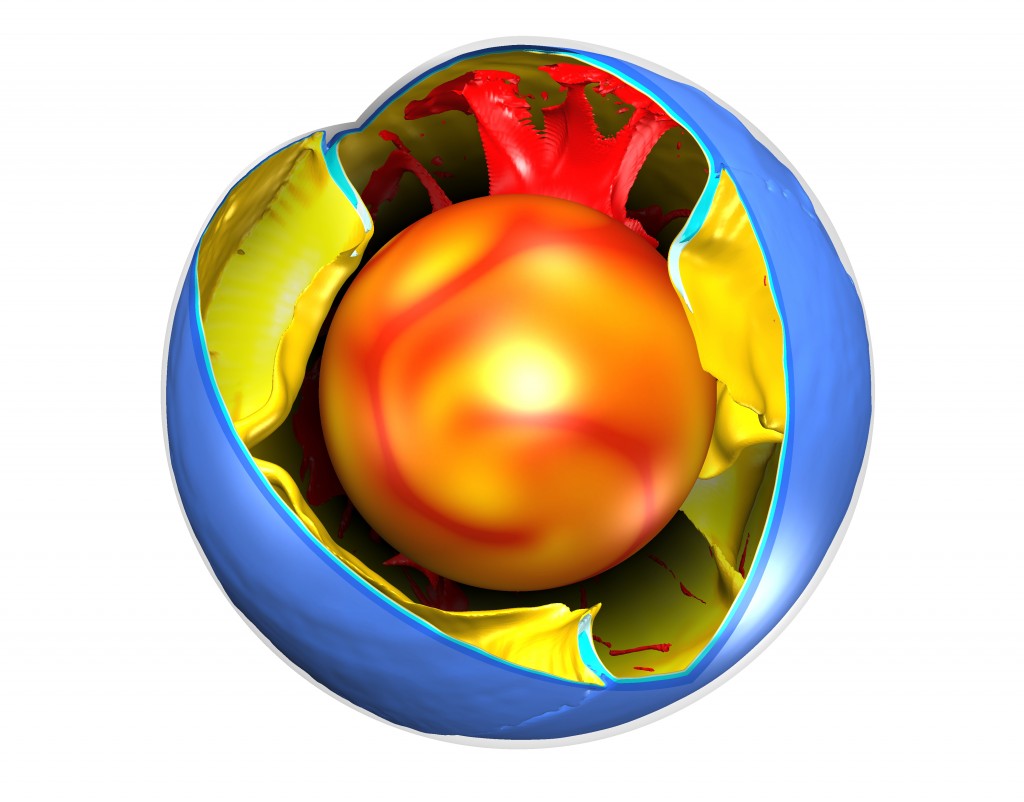The greatest achievement of the generation of Earth Scientists now retiring is the concept of plate tectonics. The insight that the earth’s surface is made up of rigid plates that move has shed light on all aspects of Earth Science, from palaeontology to geophysics to the study of ancient climates. What’s less well known is that the way the plates interact has changed over time. Key plate tectonic features such as subduction, didn’t happen for large periods of earth history.

Cut-away diagram showing modern convection from computer modelling. White is hot rising plumes, black cold sinking plates . Image used with permission of Fabio Crameri.
Earth scientists have a pretty good idea of the details of how modern plate tectonics works. This has required the integration of indirect observation of modern subduction zones (using geophysical techniques) with direct study of rocks that have been inside subduction zones (such as eclogites) plus the creation of subduction zones ‘in silico’ (with computer modelling).
Of these 3 methods of study, only the first (direct observation) cannot be used on the ancient earth. So what do the rocks and computer models tell us?
Old rocks are odd
We’ve known for a while that ancient rocks (Eoarchean–Mesoarchean, older than 2.5 Ga1) are very different from modern ones. Often they consist of greenstone belts – containing an unusual lava called komatiite – surrounded by large areas of granitic gneiss. The pattern of metamorphism in these rocks shows high temperatures, even at shallow depths.
The chemistry of the igneous rocks tells a similar tale. Komatiites only melt at temperatures of around 1600°C – 400 degrees hotter than modern basalt lava. Granitic rocks have tonalite–trondhjemite–granodiorite compositions and are thought to have formed from direct melting of basaltic rock – unlike granites formed above subduction zones today.
Rocks characteristic of modern subduction – blueschists and eclogites – are not found in rocks this age. There is a pretty good consensus, based on field evidence and model modelling, that subduction did not happen in the early earth. The earth’s mantle was much hotter and more heat was flowing up through the crust. Hot rocks are weak rocks – forcing a slab of rock into the deep mantle requires it to be cold and hard. Hotter rocks act not as rigid slabs but as soft blobs.
Computer modelling confirms the importance of temperature, both of the crust and the underlying mantle. Models are our best hope of understanding what a hot planet without subduction looked like. More like a bubbling pan of porridge perhaps, with tectonics dominated by hot upwelling plumes and lithospheric delamination, with blobs dripping-off down again. Some studies of mantle mixing suggest a ‘stagnant-lid’ model where the earth’s surface layer doesn’t move at all.
Subduction starts
At some point in time between 3.2–2.5 Ga, subduction started. The planet had cooled enough that a lithospheric plate stayed rigid enough to sink down into the mantle. Evidence for this is found in ‘paired metamorphic belts’. Rocks within the subduction zone remain cool at depth (as they are pushed down before they can get as hot as the surrounding rocks) and form eclogites or high-pressure granulite rocks. Rocks nearby in the overriding plate are much hotter and enjoyed granulite–ultrahigh temperature metamorphism.
Mathematical modelling of the earth suggests subduction started because the earth cooled below a particular threshold. As an explanation, this is a little dull. Much more excitingly, coverage of a recent paper suggests massive meteorite impacts about 3.2 Ga could have broken up the surface and somehow kickstarted plate tectonics. Scientists who study impacts are always really keen to use them to explain events or features on earth, whereas other scientists are sceptical, preferring to explain them via things that they study. We’ll need to wait to see who is right about this one (but my money is on the dull explanation).

Cut-away diagram showing modern convection from computer modelling. Red is hot rising plumes, blue cold sinking plates. Image used with permission of Fabio Crameri.
Subduction as a cure for boredom
When subduction first started, mantle temperatures were still 175–250 °C hotter than today. Hotter, softer slabs are more likely to break off, perhaps making subduction something that stopped and started.
Blueschists and low-temperature eclogites, high-pressure & low-temperature rocks that are found in modern subduction zones are not found until the the Neoproterozoic at 600–800 Ma. Mantle temperatures by then were less than 100 °C greater than today – this marks the wide spread development of modern-style (cold) subduction on Earth. Cold slabs of oceanic lithosphere break-off deep, allowing large volumes of dense oceanic crust to pull continental lithosphere down, creating the first ultra-high pressure metamorphic complexes.
The Neoproterozoic is the end of what is known as the ‘boring billion’ – a time of tedious environmental and evolutionary stability. A recent open acess paper in Geology suggests a link between the exciting changes that followed (glaciations! Cambrian explosion!) and the onset of subduction. The boring billion was stable in part because most continental crust was part of a supercontinent called Rodinia. The paper argues that the disruptive effects of the onset of cold subduction broke Rodinia apart, setting off a chain of events that transformed the world.
—–
The early earth was a very different planet. Understanding it better informs the general subject of planetology. As we get more and more data about other planets (both within and beyond our solar system) it’s natural to speculate on their tectonic activity. Why does Venus not have subduction? Does subduction here exist because of life and its role in moderating climate and creating the earth’s oceans? Ancient rocks and computer models may help us answer these questions as much as probes and telescopes.
REFERENCES
Brown M. (2014). The contribution of metamorphic petrology to understanding lithosphere evolution and geodynamics, Geoscience Frontiers, DOI: 10.1016/j.gsf.2014.02.005
Available here
Cawood P.A. & Hawkesworth C.J. Earth’s middle age, Geology, DOI: 10.1130/G35402.1
Available here
Gerya T. (2014). Precambrian geodynamics: Concepts and models, Gondwana Research, 25 (2) 442-463. DOI: 10.1016/j.gr.2012.11.008
Available here

Pingback: Şunu tivitledim: Levha Tektoniği kuramı da evriliyor. Ders kitaplar... | Ömer KAMACIÖmer KAMACI
Nice post Simon. The interesting thing about the debate over the nature or existence of Precambrian plate tectonics is the wide range of estimates for the start of the current regime with continuous cold slab subduction – lots of different lines of evidence, which have yet to converge, which means researchers go with the indicators they specialise in (and trust). I think, in the next decade, that convergence could start to happen – I suspect towards the older end of the spectrum myself, but I may yet be surprised!
Curious about the role of water in the early earth as compared to now in relation to subduction at present and the lack of subduction 3Gya. In undergrad school, we are taught that eclogites and such are able to form because of the presence of water to enable the downgoing slab to stay cold and lower the melting point with increased depths. So if higher crustal temperatures existed in the past, did the presence of water, not just in glacial form, enable the crust to cool by infiltration of water into the cooler, denser portions of the crust that may have already been undergoing some form of subduction without low temperature-high pressure conditions. Is it possible that early ”subduction” was in reality low angle thrust without a downwarping slab and with the presence of water enable the lower portion of the thrust sheet to stay cool and descend into the warmer mantle thus forming ecologite facies and other related rocks? Is this making any sense? Im gonna go back to making cross sections now. Thanks
Welcome!
Water certainly is important in subduction, but I’ve not heard anything about it being important in the changes of subduction over time.
From memory, some of the earliest rocks known are water-borne sediments. So the surface has always been cold (from a rock’s point of view) so that water is liquid at the surface (or occasionally solid). So water may have always been sinking into crust and altering it, so it doesn’t seem a good place to a look for explanations of why subduction has changed over time. For that, reductions in temperature within the earth seem a better bet.